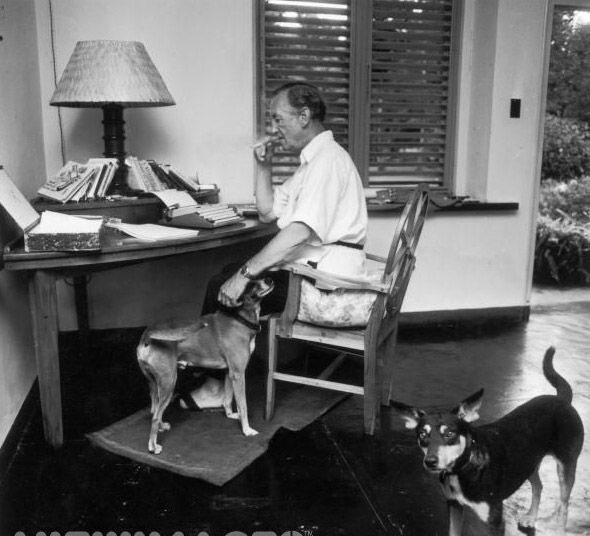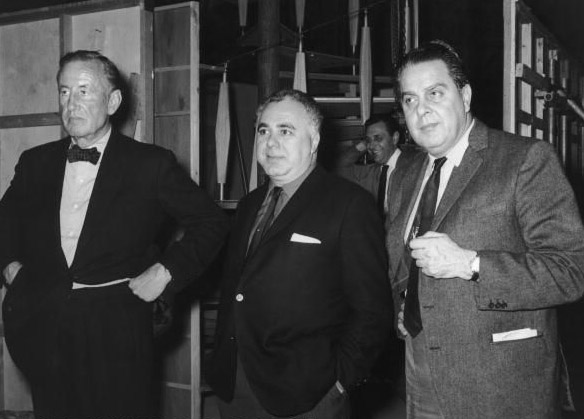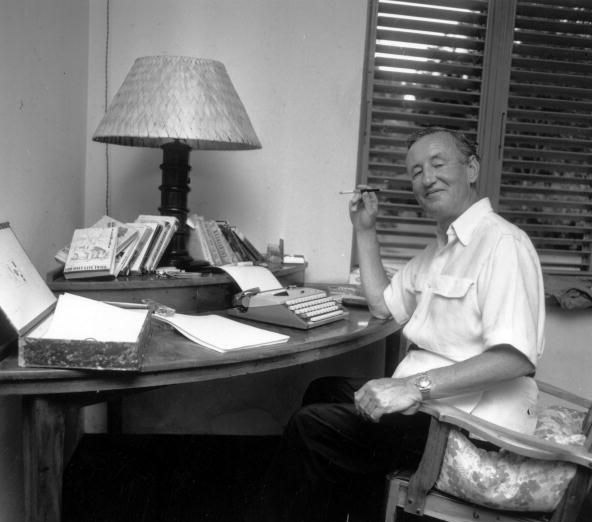Contact:
007museum@telia.com
 Phone+4648112960
Open Daily 10-17 Sat 10-14 Media
To do and see
Buy/Köp info
Links
Phone+4648112960
Open Daily 10-17 Sat 10-14 Media
To do and see
Buy/Köp info
Links
James Bond Theme Party
PPKGuns Omega
Bmw
Bollinger Corgi,
Cd,
Swatch
Posters,
Specials James Bond store
London’s Dukes Bar serves James Bond Martinis
Visit Dukes Bar at:
http://www.dukeshotel.com/
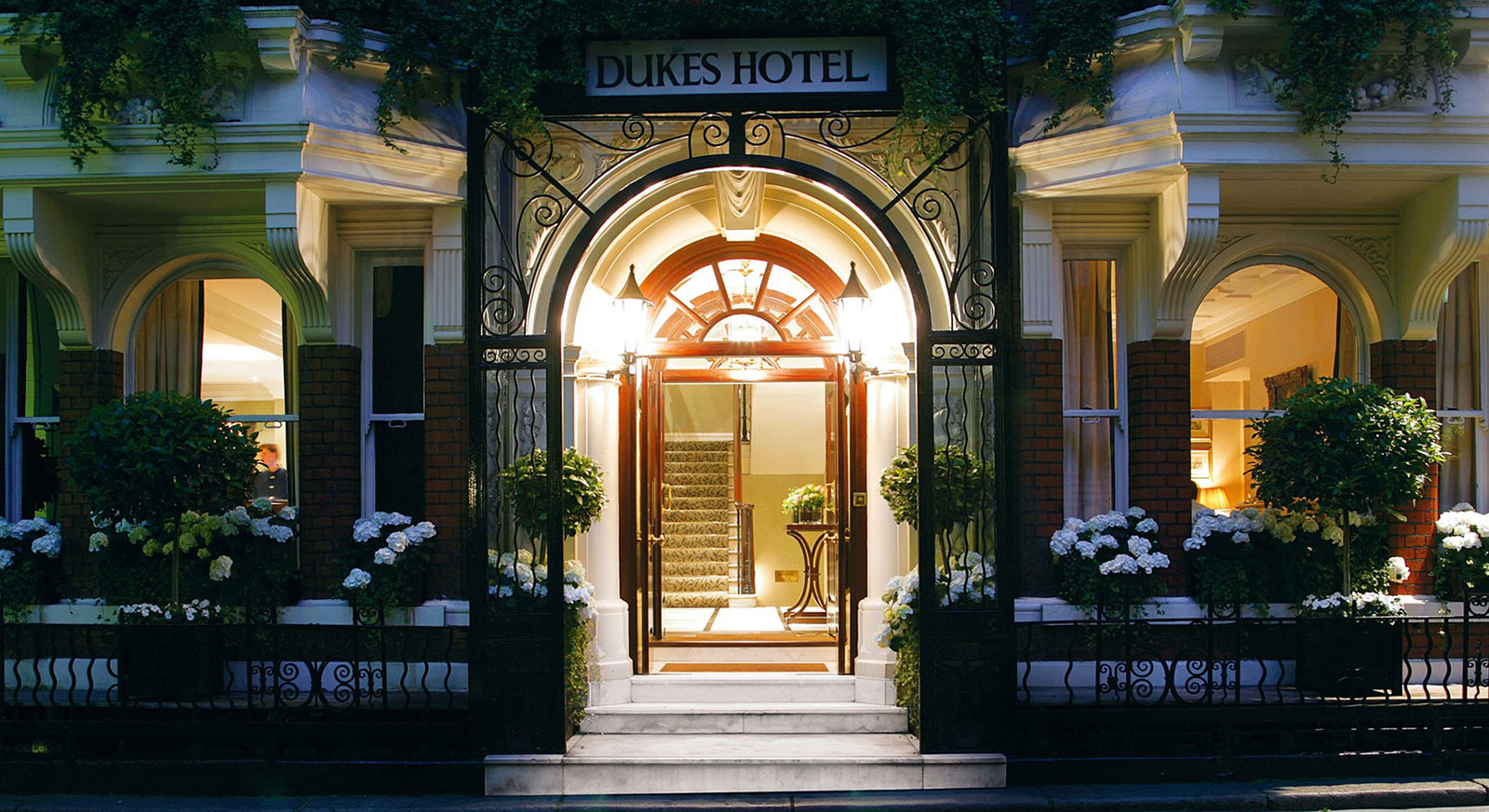
As Sir Ian Fleming’s former watering hole, Dukes bar in
London is a pilgrimage site for James Bond fans. After
all, legend has it that it’s here where Fleming coined
the catchphrase “shaken, not stirred” for his 007
British Secret Service agent, a slogan that would define
Bond beyond simply his taste in cocktails.
Just ask
Dukes bartender Alessandro Palazzi, who is as passionate
about his trade as his fondness for the spy thriller
series, which this year celebrates the 50th anniversary
of the first Bond film to hit the silver screen. In
honor of the spy hero, Palazzi created two martini
recipes in Fleming’s honor since arriving at the bar
five years ago: the Fleming 89 and Fleming’s Classic
Vesper.
According to Palazzi, the fact that Bond drinks his
martinis “shaken, not stirred,” serves as a larger
statement on the international man of mystery.
When
Fleming wrote his first book in the 1950s, everything in
society was strictly prescribed, including drinks and
cocktail hour, Palazzi explains. Martinis were only ever
served as an apéritif before dinner, drinks were never
mixed with two white spirits and, moreover, cocktails
were always stirred.
But not for Bond. James Bond. In the first
installment of the series, Casino Royale, 007 doles out
specific instructions to the barman on how to prepare
his drink, a cocktail that would later become known as
the Vesper, after Bond girl Vesper Lynd. The recipe:
three measures of Gordon’s, one measure of vodka, half a
measure of Kina Lillet, with a slice of lemon — shaken.
Rules and conventions are thrown out, as Bond marches to
his own drum and drinks what he likes, Palazzi says. “He
likes to show off.”
‘Fleming and Bond-inspired martinis’
At Dukes, Palazzi has recreated the Vesper by using
No. 3 London Dry Gin, Lillet Blanc, Angostura bitters,
and Potocki vodka, a Polish vodka, in honor of the
real-life inspiration for Vesper Lynd, Polish-born
Christine Granville who was a wartime spy and reportedly
Fleming’s lover.
It’s the most requested Bond-themed martini at the
bar, where Palazzi serves about 50 a night at £16.95
(€21) a pop. It’s a steep pricetag, but Palazzi points
out that drinkers get a cocktail and a show with their
order, as drinks are executed with the pomp and
circumstance expected of a former Fleming hangout:
guests watch, seated at their tables as Palazzi wheels
out a trolley laden with bottles of spirits which have
just been pulled from the deep freeze.
The Fleming 89, meanwhile, was created in partnership
with London-based perfumery Floris whose No. 89 Eau de
Toilette was Bond’s signature scent. Inspired by tonka
beans used in the cologne, Palazzi infuses 750 ml of
Russian vodka with a handful of the vanilla-scented
beans to create his special elixir. In a frosted martini
glass, he adds a sugared rose, the infused vodka,
English vermouth, Lillet, a few drops of chocolate
bitter, tops it off with Russian vodka and as a final
touch, gives it a spritz of rose liqueur, to create a
chocolaty, dessert-like cocktail for £18.95 (€24).
With the Bond franchise celebrating the 50th
anniversary of the first movie release, here are a few
tips from Palazzi on how to clink to the milestone with
the kind of martini Bond himself would approve of.
* Keep spirits in the freeze to make sure they’re ice
cold.
* If you like you’re drinks slightly diluted, do it
like Bond and shake the martini mix. Otherwise, stir.
* If you want to make it with ice, make sure to drain
the water first.
* Work fast.
* Use an organic lemon as you want the oils from the
peel, not the wax, to penetrate the drink.
* Martinis were meant to be sipped, not gulped.
Ian
Fleming 108 Year 28 maj 2016
sida
2
The Books 14 novels
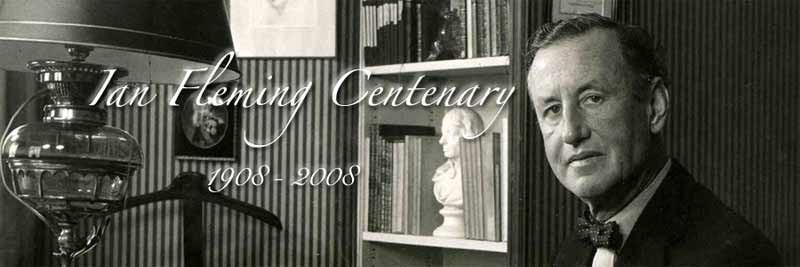
|
Author: Ian Fleming
Published: 1953 to 1966
Novels: 14
Novelisations: 0
Non-Fiction: 2
The Life of Ian
Fleming (1908-1964)Ian Lancaster Fleming, born 28 maj
1908
i Mayfair, London, died 12 augusti 1964 Canterbury,
|
Ian Fleming the writer 100 years 1908-2008 Centenary
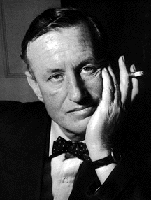
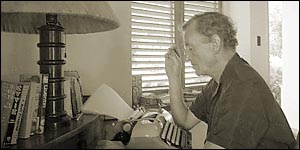
|
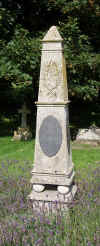 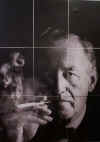
Fifty-six-year-old Ian Fleming died of a
heart
attack on the morning of
August
12,
1964,
in
Canterbury,
Kent,
England, and was later buried in the churchyard of
Sevenhampton
village, near
Swindon.
Upon their own deaths, Fleming's widow, Ann Geraldine Mary Fleming
(1913–1981), and son Caspar Robert Fleming (1952–1975), were buried
next to him. Caspar committed suicide with a drug overdose. |
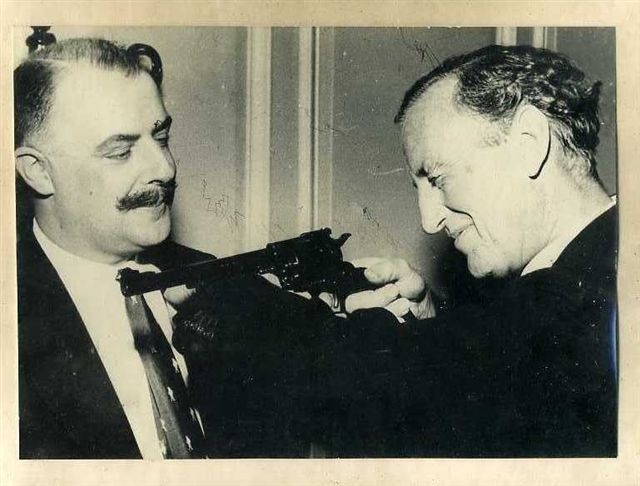
Geoffrey
Boothroyd and Ian Fleming picture from Ivan
Morelius
Geoffrey Boothroyd (Q) and Ian Fleming author
of James Bond
Writer Ian Fleming (1908-1964) created the character of James
Bond 007 |
Ian Fleming buried in
Wiltshire
Fifty-six-year-old Ian Fleming died of a
heart
attack on the morning of
August
12,
1964,
in
Canterbury,
Kent,
England, and was later buried in the churchyard of
Sevenhampton
village, near
Swindon.
Upon their own deaths, Fleming's widow, Ann Geraldine Mary Fleming
(1913–1981), and son Caspar Robert Fleming (1952–1975), were buried
next to him. Caspar committed suicide with a drug overdose.
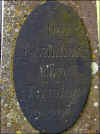
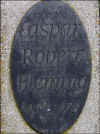
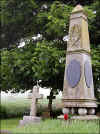 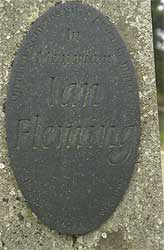
It was in the late 1950s that Fleming, and his second wife Ann, made the
move to Wiltshire to buy up and then pull down the large 16th-century
manor of Warneford Place in Sevenhampton and in its place build the modern
Sevenhampton Place
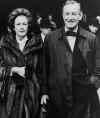 |
|
Spouse(s) |
- Ann Geraldine Charteris
- (1952–1964, his death)
Son Casper1952-1975
|
|
Relatives |
|
|
|
Ian Flemings Goldplatetypewriter Royal Quiet de
Luxe.
1952 beställde en gyllene skrivmaskin från The Royal Typewriter Company
i New York.
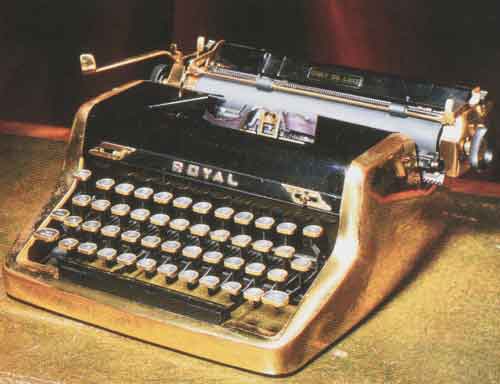 |
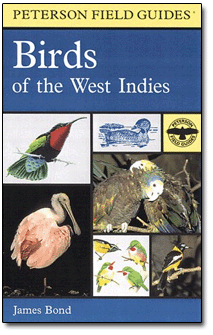 |
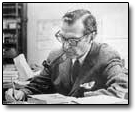 James
Bond, the Author James
Bond, the Author
The Origin of the Name James Bond
James Bond (January 4, 1900 – February 14, 1989) was a leading American ornithologist whose name was appropriated by writer Ian Fleming for his fictional spy James Bond.
"I wanted the simplest, dullest,
plainest-sounding name I could think of. James Bond seemed perfect."
-Ian Fleming
While he may be the world's most famous,
glamorous secret agent, let's face it, his name is pretty dull. In a way
it is fitting, Fleming achieved exactally what he wanted to with the name.
He actually found it sitting on his bookshelf in the author of a book
entitled "Bird's Of The West Indies." And like that, history was
made!
|
The Life of Ian
Fleming (1908-1964)Ian Lancaster Fleming, född 28 maj
1908
i Mayfair, London, död 12 augusti 1964 i Canterbury, Kent (i en hjärtattack),
var en brittisk (engelsk) journalist och författare som främst är känd
för att ha skapat
James
Bond. Det blev tolv romaner och två novellsamlingar om denne
gentlemanna-agent.
Dessutom har han skrivit barnboken
Chitty
Chitty Bang Bang.
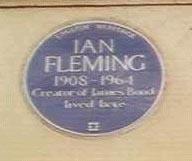
Ian Fleming (1908,05,28-1964,08,12) created the
character of James Bond,
who debuted in the 1952 novel Casino
Royale
Ian Fleming på 22 Ebury Street i
London.
Photo by Anders Gardefalk
|
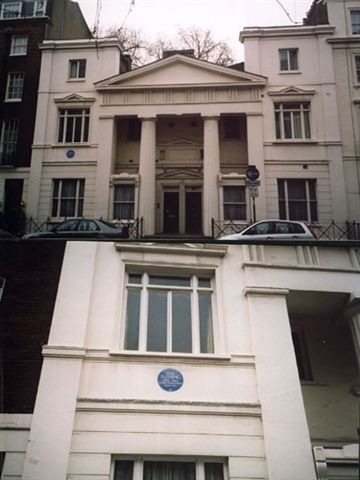
|
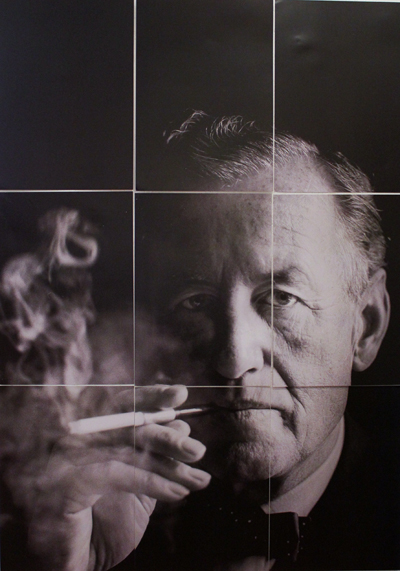
Ian Fleming big
|
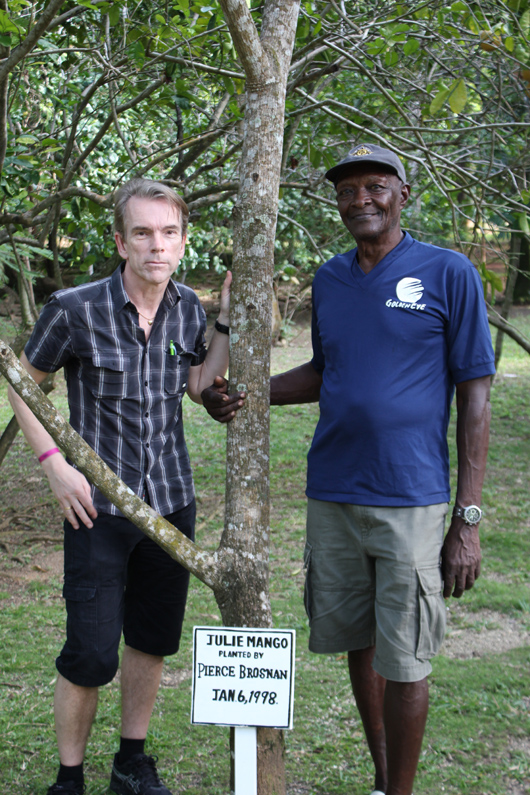
James Bond (Gunnar Schäfer) and Mr Ramsey Ian Flemings gardener: with
tree planted by Pierce Brosnan januari 6 1998.
Fleming's gardener, Ramsey
Dacosta,
who still works at Goldeneye.
Fleming’s gardener, Ramsey Dacosta, who still works at Goldeneye
(now
in guest relations) and invariably referred to Fleming as the Commander,
told me Mr Bond that, his old employer would bring conch to an
octopus at the reef, and, as in the short story, “the octopus would
return the shell.” Bond makes a brief appearance in “Octopussy” to
arrest Smythe for a wartime theft, but Smythe takes his own life, with
help from the octopus. Fleming died a much less dramatic death from a
heart attack in 1964 in England, where he is buried.
|
Goldeneye was the name given by
Ian
Fleming to his estate in
Oracabessa,
Jamaica. He
purchased the land next door to Golden Clouds estate and built his house
on the edge of a cliff, overlooking a private beach.]
The original house was a modest structure consisting of three bedrooms and
a swimming pool. Fleming's coterie of friends who visited him at Goldeneye
included actors, musicians and filmmakers
.
Ian
Fleming. How to write a best-seller?
”Luckily i had an Island hideway”.

Ian Fleming. How to write a best-seller?
Luckily i had an Island hideway.
At the Goldeneye resort in Jamaica own by Chris Blackwell you can se
this picture, taken by James Bond Gunnar Schäfer who runs the James Bond
007Museum in Sweden Nybro.
Ian Fleming villa
Ian fFemming
Jamaica_airport_fleming
Goldeneye-map.pdf
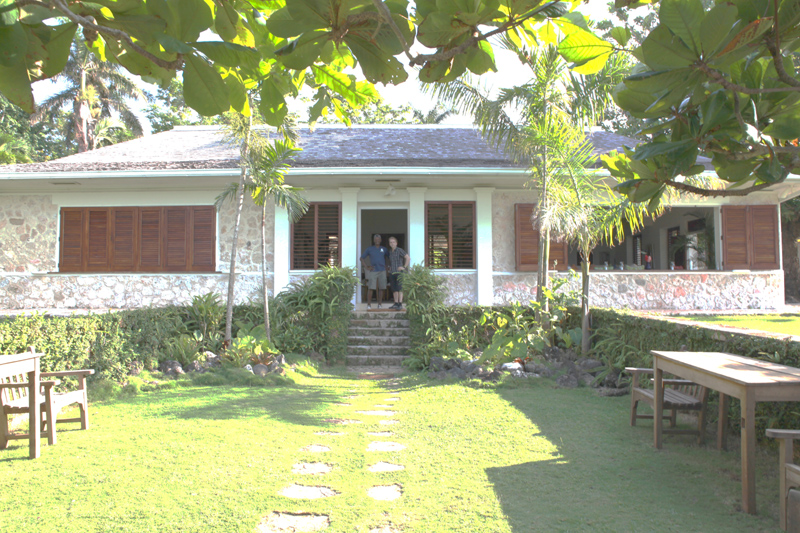
|
The Ian Fleming
Novels and Short Stories
“I take a ridiculous
pleasure in what I eat and drink.”
—James Bond
Over the past 15 years, James Bond’s bar
choices have been parsed down to exactly three drinks: vodka
martinis (shaken, not stirred), champagne, and whiskey on the
rocks. This strict formula has been in place since The Living
Daylights. But it wasn’t always that way.
The literary 007 (and by extension, the film
version) takes his drinking habits from his creator, Ian Fleming.
Bond often shares a love for cocktails such as gin and tonics or
stingers that would strike most of us as highly atypical.
According to biographer Andrew Lycett, Fleming preferred gin and
vermouth, and also liked the exotic drinks found around his
winter home in Jamaica. “Fleming himself really didn’t
hold his drink very well. More than two glasses of wine at lunch
time and he was done for.”
According to notes from the archives of Random
House, Fleming’s publisher, this concern with sobriety found
its way into the novels: “Drink relaxed Bond. His only rule
was not to get drunk but perhaps for 20 years he had hardly gone
to bed cold sober. His other rules were not to drink at midday or
after dinner, and never to drink liqueurs.” Why does 007
prefer his martinis “shaken and not stirred”? Lycett
theorizes that Fleming thought stirring a drink diminished its
flavors.
Interestingly, Fleming’s novels reverse
the simplification trend found in the films. In the initial
books, the drinks are often window dressing, a device to show
that Bond is indeed eating dinner in a swank restaurant or is
traveling in a foreign country. But as the series progresses, the
drinks and the circumstances surrounding them become increasingly
more complex, more integral to the plot. This can be attributed
to Fleming’s maturation as a writer, his increased financial
success, and his failing health. The latter found voice in the
air of foreboding and melancholy that pervades the later novels,
such as the opening chapters of both Goldfinger and Thunderball,
where Bond’s drinking leads to ruminations on health and
mortality.
Obviously, Fleming used alcoholic beverages to
emphasize the exotic locations to which Bond travels, with 007
often imbibing local wines or liquors. Some are very specific,
such as when he drinks raki in Turkey or saké in Japan. Some are
more general: when he’s in the Western Hemisphere Bond
usually has bourbon, and in the Eastern, he often drinks scotch.
Above all, he prefers “solid” drinks.
There are many reasons for James Bond’s
appeal, including foreign locales, beautiful women and extreme
danger. But a large part is certainly his love for the finer
things (echoing the growth of our modern consumer culture), from
clothes and cars to good food and well-made drinks. If you
haven’t read Fleming’s novels, you might be surprised
at the James Bond revealed within: a bored and somewhat cynical
civil servant who sometimes drops his jacket on the floor. But as
this section tries to show, you’ll also encounter a man who
definitely knows what he wants, especially at cocktail hour. And
if we ourselves live vicariously through 007, at least we can
have a few great martinis on the way.
IAN FLEMING
Born in 1908, Ian Lancaster Fleming was a former journalist and banker who
went on to create one of the most enduring characters in literary history.
During World War II, Fleming served with British Naval Intelligence, where as
assistant to the director he helped plot covert operations and, in a memo to
America's William "Wild Bill Donovan," outlined a structure for the
OSS, later to become the CIA. These experiences, combined with a natural ability
at writing, led to the creation of secret agent James Bond.
In 1952, Fleming wrote Casino Royale at his Jamaican estate, Goldeneye. Like
all his novels, it was met with mixed reviews from critics but delighted
enthusiasm from readers. For the next 12 years, Fleming would pound out a new
novel each year, his fan base growing with each installment, and eventually
including the President of the United States, John F. Kennedy.
After several abortive attempts to translate Bond's adventures to the big
screen, Fleming was convinced in 1961 to let Albert R. Broccoli and Harry
Saltzman have a go of it. The result was Dr No, by any standards a
trememdous hit and the beginnings of a cultural phenomenon that's now into its
fourth decade with no signs of slowing. Fleming lived to see From Russia With
Love hit theaters the following year, but died in 1964 before the release of
Goldfinger, the film that would take 007 to unimagined heights of
popularity.
Outside the Bond novels, Fleming wrote a regular column for the Sunday Times,
the non-fiction book The Diamond Smugglers and the perennial favorite
children's tale, Chitty-Chitty Bang-Bang.
In 1952, Fleming had a typewriter gold-plated and it's been said he used it
to write all of the Bond novels at Goldeneye. On May 5, 1995, the typewriter was
auctioned off by Christie's to an anonymous bidder for over 56,250 pounds. The
bidder was later revealed to be movie Bond number 5,
Pierce
Brosnan.
Casino Royale (1953)
Live And Let Die (1954)
Moonraker (1955)
Diamonds Are Forever (1956)
From Russia With Love (1957)
Doctor No (1958)
Goldfinger (1959)
For Your Eyes Only (1960)
Thunderball (1961)
The Spy Who Loved Me (1962)
On Her Majesty's Secret Service (1963)
You Only Live Twice (1964)
The Man With The Golden Gun (1965)
Octopussy and the Living Daylights (1966) |
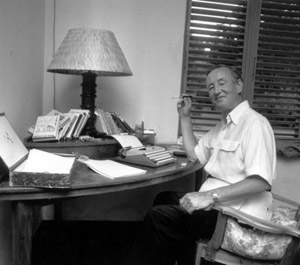
|
The son of a Conservative MP and
the grandson of a Scottish banker, Fleming was born into a family of wealth and
privilege and was educated in England, Germany, and Switzerland. Before settling
down as a full-time writer, Fleming was a journalist in Moscow (1929–33), a
banker and stockbroker (1935–39), a high-ranking officer in British naval
intelligence during World War II, and foreign manager of the London Sunday
Times (1945–49).
Casino Royale
(1953) was the first of his 12 James Bond novels. Packed with violent action,
hairbreadth escapes, international espionage, clever spy gadgets, intrigue, and
gorgeous women, the books became international best sellers. The Bond books
gained wide popularity in the United States after the newly elected president,
John F. Kennedy, named a Bond novel on his list of favourite books in 1961.
Bond, with his propensity for
gambling and fast cars, became the prototype of the handsome, clever
playboy-hero of the late 1950s and '60s. He was the symbol in the West of the
burgeoning consumer age, indulging in only the best brand-name products and
enjoying access to the foremost electronic gadgets of his day. To some readers,
Bond's incessant name-dropping of commercial products was off-putting, but the
tactic enabled Fleming to create a realism unusual in the popular fiction of his
day. Bond's mannerisms and quirks, from the way he liked his martinis
(“shaken, not stirred”) to the way he introduced himself (“Bond, James
Bond”), soon became famous around the world. All the Bond novels, notably From
Russia, with Love (1957), Dr. No (1958), Goldfinger
(1959), and Thunderball (1961), were made into popular motion
pictures, although many deviated from Fleming's original plots.
Fleming's books were roundly
criticized by many highbrow critics and novelists. Paul Johnson lambasted the
Bond phenomenon in a famous essay titled “Sex, Snobbery, and Sadism,” and
the spy novelist David Cornwall (John le Carré) criticized Bond's immorality
(“He's a sort of licensed criminal who, in the name of false patriotism,
approves of nasty crimes”). Feminists have long objected to Bond's
chauvinistic ways, and the Soviet Union, as the enemy in so many of Bond's Cold
War capers, attacked Fleming for creating “a world where laws are written with
a pistol barrel.” Fleming countered that “Bond is not a hero, nor is he
depicted as being very likeable or admirable.…He's not a bad man, but he is
ruthless and self-indulgent. He enjoys the fight—but he also enjoys the prizes.”
Despite (or because of) such
criticism, the Bond stories grew in popularity. The 007 trademark became one of
the most successful in merchandising history, giving birth in the 1960s to a
spate of Bond-related products, from toys and games to clothes and toiletries.
James Bond films continued into the 21st century, and they have reportedly
grossed more than $1 billion; the book series has continued as well, under new
writers. There are numerous Bond-related Internet sites and fan clubs around the
world.
Fleming also published two
collections of short stories featuring Bond. In addition, he wrote a children's
book, Chitty Chitty Bang Bang (1964), which was made into a
feature film and whose main character, Commander Pott, perhaps summarized best
the Fleming/Bond philosophy of life: “Never say ‘no' to adventures. Always
say ‘yes,' otherwise you'll lead a very dull life.” Fleming's life and
personality—from his wartime service and his caving and shark hunting to his
and his family's hobnobbing with the rich and famous (when Fleming's father died,
Winston Churchill wrote the obituary)—made him, in the opinion of many, a more
compelling figure than even Bond, and as such he has been the subject of several
biographies, including Andrew Lycett's Ian Fleming (1995).
Ian Fleming
Bondförfattare 1953-1966
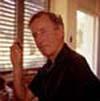
Uppväxten
Ian Lancaster Fleming föddes den 28 maj 1908 i Mayfair,
London. Han var den andra bland tre bröder. Hans äldre bror
hette Peter och hans yngre, Michael. Deras farfar
var den skotske bankmannen och miljonären Robert Fleming,
så deras familj var mycket rik. När Ian var nio år dog hans
far, Valentine, som officer i första världskriget,
vilket gjorde hans mor, Evelyn, till änka vid 32 års
ålder. Hans fars tidiga och heroiska död tillsammans med en
uppfostran starkt präglad av hans mor hade ett stort inflytande
på honom under resten av hans liv.
Fleming studerade vid Eton (där han vann deras "Victor
Lodurum" [Tävlingarnas segrare] två år i rad). Ett av
dessa år, 1924, vann han alla grenarna utom höjdhopp och 100
yard, en prestation som aldrig slagits varken tidigare eller
senare i Etons historia. Hans ungdom dominerades av småproblem,
det var inte sällan som bilar eller kvinnor var orsaken. Han
lämnade Eton för att börja vid militärskolan i Sandhurst, men
han passade inte som soldat, så han lämnade Sandhurst för att
börja på en skola i Kitzbühel, Österrike.
Ian får jobb som journalist
1931 misslyckades han att få ett jobb för utrikesdepartementet
och började istället jobba på nyhetsbyrån Reuter, där han
bland annat bevakade rättegångarna mot de sex engelska
ingenjörerna i Moskva 1933 som blev anklagade för spioneri. Då
han kom hem från detta uppdrag blev han kontaktad av
utrikesdepartementet, som var mycket nyfiken om hans åsikter om
Moskva och Sovjetunionen. Efter den goda rapporteringen av
rättegången slutade han jobba för Reuter och tog en
styrelsepost i en bank i London, där han jobbade under de
kommande sex åren. Det var under dessa år som han än en gång
sändes till Moskva. Officiellt ingick han i en
handelsdelegation, men inofficiellt jobbade han
utrikesdepartementet (som hållit ett öga på den lovande unge
mannens karriär sedan spionrättegångarna).
Underrättelseagenten Fleming
1939 blev han inbjuden till lunch med amiral Godfrey, som
precis blivit utnämnd till chef för den engelska marinens
underrättelsetjänst. Fleming började jobba för Godfrey och
var inblandad i många av britternas hemliga operationer under
kriget.
Han fick även stora kontakter med det som något år senare
skulle bli den amerikanska underrättelsetjänsten OSS
(som sen bytte namn till dagens CIA). Fleming hjälpte dem bland
annat att skissa hur man skulle kunna bygga upp den nya byrå
(dvs OSS) från grunden.
Till exempel bygger karaktären Felix Leiter på Thomas
Leiter, miljonären Joseph Leiters son och nära vän med
Fleming. Joseph var den som sålde landägorna runt Langley till
OSS.
Miss Moneypenny-karaktären är baserad på Lady
Victoire "Paddy" Ridsdale, som jobbade med Fleming
i "Room 39" vid marinens underrättelsetjänst
under andra världskriget. Fleming brukade "retas" med
henne och kasta sin hatt över rummet på ett kappställ som han
senare lät Bond fortsätta med i böckerna. "Room 39"
var inblandat i mycket av de hemliga operationerna under kriget,
bland annat den bluff, kallad "The Man Who Never
Was", som lurade Tyskland vid Dagen D; de lade hemliga
dokument på en död man och släppte kroppen i havet, så att
tyskarna skulle kunna hitta den, då den flöt i land. Det var
Paddy som skrev kärleksbrev och andra personliga saker, som
kroppen hade på sig.
Under kriget drabbades Fleming av (minst!) två dödsfall i
hans närmaste omgivning; hans dåvarande flickvän, Muriel,
avled i sömnen under en tysk flygräd över London hösten 1945
och hans bror Michael avled som POW av en skada efter
slaget vid Dunkirk 1940.
Efter kriget - Ian skaffar hus
på Jamaica
Den 10 november 1945 blev kommendörkapten Fleming släppt från
sina militära skyldigheter, och började leta efter någonting
annat att göra. Han fick jobb av Lord Kemsley att
organisera en utrikesbyrå åt dennes mediaföretag (Kempley
Newspaper, som ägde bland annat Sunday Times).
Fleming fick för detta den ganska stora lönen 5000 pund om
året samt två månaders betald semester. De var dessa två
månader (januari och februari) som han spenderade på sitt
nyinköpta hus vid Oracabessa på Jamaicas norra sida. Han döpte
huset till "Goldeneye". Detta namn kommer antingen
från en operation med samma namn som Fleming planerade under
kriget som gick ut på att förstöra Spaniens hamnar om Tyskland
skulle invadera landet, eller också från Carson McCuller's
bok "Reflection in a Golden Eye" (det kan ju
också vara så att även operationen tagit sitt namn från
boken).
James Bond föds
Det var här som Fleming i början av 1952 skrev sin första bok
om agenten James Bond, "Casino Royale". Namnet
på sin agent tog han från en författarkollega som skrivit
boken "Birds Of The West Indies".
Det finns flera föreslagna anledningar varför han började
skriva, en var att han gjorde det för att "komma över
chocken att han skulle gifta sig vid 43 års ålder". En
annan kan vara att han helt enkelt tröttnade på att vara
"Peter Fleming yngre bror". Peter var vid detta laget
redan en välrespekterad författare.
Efter att första utkastet till romanen var färdigskriven gifte
sig Fleming den 24 mars 1952 med Anne Rothermere. Detta
skedde i Port Maria's stadshus och Flemings vän Nöel Coward
och hans sekreterare var vittnen.
Ian var så exalterad över sitt författande och att gå i sina
egna favoritförfattares (Raymond Chandler, Eric Ambler, Georges
Simeon med flera) fotspår att han den 17 maj 1952 beställde en
gyllene skrivmaskin från The Royal Typewriter Company i
New York. Det var på denna som han finputsade "Casino
Royale" och skrev alla efterföljande böcker på.
I augusti samma år födde Anne deras son, Caspar Robert
och i oktober fick "Casino Royale" ett OK från
bokförlaget (Jonathan Cape), med en utgivning i april
1953.
För att lätta på skattebördan som hans nya karriär skulle
innebära startade Fleming ett företag, kallat Glidrose
Productions, med han själv som direktör. Detta företag
hade sedan alla rättigheter till romanerna.
Ian Flemings vän, vapenexpert Geoffery Boothroyd, lånade
honom en gång en Walter PPK-pistol. Fleming tyckte så mycket om
vapnet att han såg till att Bond hade en och som tack för
hjälpen baserade han karaktären Q på honom.
Det sägs att Fleming blev så imponerad av Sean Connery i
rollen som James Bond att han i nästa bok ("I Hennes
Majestäts Hemliga Tjänst") lät Bond bli skotte! Han
uppskattade tydligen filmens Ursula Andress också, eftersom hon
dyker upp i samma bok med en "fantastisk solbränna".
Det märks att Fleming är influerad av sin uppväxt och
omvärld i böckerna, med fördomar mot både kvinnor och
färgade.
En skillnad man märker mellan böckerna och filmerna är att i
böckerna hade Bond oftast bara en kvinna/uppdrag, medan han i
filmerna brukar ha två, tre stycken. Böckerna brukar också
nämna tidigare kvinnor - och uppdrag - i efterföljande böcker
och skapar på så sätt en större kontinuitet än filmerna.
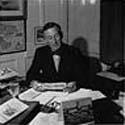 Övriga utgivningar av Ian Fleming
Övriga utgivningar av Ian Fleming
Förutom Bondböcker har Fleming även skrivit en barnbok,
"Chitty, Chitty, Bang, Bang". Detta kan man ju alltid
jämföra med Bonds "smeknamn", Mr Kiss, Kiss, Bang,
Bang. Denna bok kom ut 1964.
Den reseskildringsserie som han skrev för Sunday Times
mellan 1959-1960 kallad "Thrilling Cities", har getts
ut som en bok med detta namn.
Efter Flemings död publicerades 1965 hans sista bok, "The
Diamond Smugglers". Den har ingenting med James Bond att
göra och eventuellt visar att Fleming ville skriva om något
annat än sin berömde agent.
Slutet
Sensommaren 1964 var Fleming på semester med sin fru och son och
de bodde på hans favorithotell, Guildford i Sandwich Bay i Kent.
Där fick han en hjärtattack och han fördes till Canterbury
Hospital i Kent, där han avled strax efter. Klockan var 01:00
den 12 augusti.
Han ligger begravd i England, nära Sevenhampton, strax utanför
Swindon i Wiltshire tillsammans med sin fru Anne och hans
son Caspar. Anne avled 1981 i cancer och Caspar dog redan
1975 (självmord).
Det sägs att även om Fleming blev rik på sina böcker, så
blev han aldrig riktigt nöjd med det han skrev. Hans fru, Anne,
som hatade James Bond, sade efter Flemings död att den ende som
Bond verkligen lyckades ta livet av, var hans skapare...
Mer information om Ian Fleming
Det finns flera böcker om Ian Flemings liv, "The Life Of
Ian Fleming" av John Pearson, gjord på 60-talet, samt "Ian
Fleming" av Andrew Lycett (från mitten av 90-talet).
Två TV-filmer har också gjorts. Dessa är 'Goldeneye' och
'Spymaker'.
Ian Fleming har även skrivit följande böcker:
1957 "The Diamond Smugglers"
1959-60 "Thrilling Cities" (1965 "Laddade
Metropoler")
1964 "Chitty, Chitty, Bang, Bang"
Bakgrund
Ian Fleming var sonson till en mycket rik
skotsk
bankman, Robert Fleming, och son till officeren Valentine Fleming som dog under
första
världskriget. Ian Fleming växte upp som den äldste av tre bröder
tillsammans med sin mor Evelyn Fleming (som han enligt vissa källor kallade
"M", se
M).
Han var kusin till skådespelaren
Christopher
Lee.
Han fick en klassiskt ståndsmässig utbildning vid
Eton
och utmärkte sig där på sportarenan. En annan arena han utmärkte sig på var
dock inte gängse på Eton, nämligen den amorösa: Fleming hade samma lust till
kvinnor som sin
Agent
007.
Efter sina studier sökte han till militären där han inte passade in så väl.
Före andra världskrigets utbrott tjänstgjorde han som journalist vid Reuter
och bevakade bl.a. en
spionrättegång
i
Moskva. En
inbjudan till en lunch med amiral
Godfrey
1939 ledde till att han värvades av den brittiska
säkerhetstjänsten.
Fleming blev hemlig agent för britterna under kriget. Den amerikanska underrättelseorganisationen
OSS
fick många goda råd av Fleming då man startade upp sin verksamhet. OSS blev
grunden till dagens
CIA.
Det var också under sin tid i OSS som han först började slipa på en idé som
så småningom blev James Bond-böckerna.
James Bond
Flemings semestrar i huset Goldeneye på
Jamaica
var sysslolösa (bortsett från umgänget med de andra Londoncelebriteterna som
semestrade där, bl.a.
Noel
Coward). Fleming satte därför igång att skriva romaner. År
1952
ser
James
Bond dagens ljus i Casino Royale och sedan rullar det bara på med
ungefär en bok om året. James Bond är i mångt och mycket Ian Fleming själv.
Även om Bonds uppdrag är fiktiva så finns stoff i böckerna från Flemings
egen tid som hemlig agent och spion. Ian Fleming ledde en hemlig grupp på 200
officerare under andra världskriget och lärde då känna
Patrick
Dalzel-Job. Dalzel-Job var en agent som hade svårt att lyda order men var
språkbegåvad och en riktig hjälte. Han kunde spränga krigsfartyg, manövrera
miniubåtar och åka skidor baklänges. Patrick Dalzel-Job var själv författare
men läste aldrig böckerna om James Bond. Han avled
2003.
En annan förebild för James Bond var
Fitzroy
MacLean, en skotsk
soldat,
diplomat
och
författare.
Den
överklassbakgrund
som Fleming hade och den
koloniala
tidsanda som han vuxit upp under märks ibland tydligt i till exempel hans
beskrivning av kvinnor och färgade. Först var Fleming emot att
Sean
Connery skulle gestalta James Bond eftersom Connery kom från ett fattigt
arbetarhem i
Skottland
och dessutom inte hade gått på Eton. Fleming hade hellre sett till exempel sin
kusin, Christopher Lee, i huvudrollen. (Lee skulle dock senare få rollen som
Bondskurken
Fransisco
Scaramanga.) Efter den första filmen,
Agent
007 med rätt att döda
1962
var dock Fleming så imponerad av Sean Connery att han lät James Bonds rötter
förläggas till Skottland och få delar av sin utbildning på Fettes College,
en
internatskola
i
Edinburgh.
Efter flera turer med rättigheterna kring romanen Åskbollen (se vidare
om
upphovsrätten till romanen Åskbollen och
filmen
med samma namn), och efter ett alltför vidlyftigt leverna blev Flemings hälsa
allt sämre. Under konvalsensen från en hjärtattack skrev han barnboken
Chitty
Chitty Bang Bang. Men krafterna tröt snart och vid 56 års ålder dog han i
ännu en hjärtattack.
Ian Flemings fru sedan 1952, Anne Rothermere, hatade James Bond och ansåg
att det enda den figuren gjort var att ta ihjäl hennes make. Sonen Caspar
Robert tog sitt liv 1975 och Anne dog 1981 i cancer.
Fifty-six-year-old Ian Fleming died of a
heart
attack on the morning of
August
12,
1964, in
Canterbury,
Kent, England, and
was later buried in the churchyard of
Sevenhampton
village, near
Swindon.
Upon their own deaths, Fleming's widow, Ann Geraldine Mary Fleming
(1913–1981), and son Caspar Robert Fleming (1952–1975), were buried next to
him. Caspar committed suicide with a drug overdose.
Bondböcker efter Fleming
Efter Flemings död har andra författare fortsatt skriva om James Bond.
Kingsley
Amis skrev under pseudonymen Robert Markham boken Colonel Sun
(1968). Mellan åren
1981
och
1996
skrev
John
Gardner 16 st böcker. Sedan har
Raymond
Benson skrivit 12 böcker om Bond och numera är
Charlie
Higson den officielle Bondförfattaren.
Filmer om Fleming
Fleming har gestaltats på film två gånger: dels i filmen Goldeneye
(1989) med Charles Dance i huvudrollen, och året efter i Spymaker med
Jason Connery (Sean Connerys son) som Fleming.
Bibliografi
- Casino Royale (1953; Casino Royale)
- Leva och låta dö (1954; Live And Let Die)
- Attentat (1955; Moonraker)
- Döden spelar falskt (även Diamantfeber) (1956; Diamonds
Are Forever)
- Kamrat Mördare (även Agent 007 ser rött) (1957; From
Russia With Love)
- The Diamond Smugglers (1957) (ej Bond)
- Döden på Jamaica (även Dr. No) (1958; Doctor No)
- Goldfinger (1959; Goldfinger)
- Ur dödlig synvinkel (noveller) (1960; For Your Eyes Only)
- Åskbollen (1961; Thunderball)
- Älskade spion (1962; The Spy Who Loved Me)
- I Hennes Majestäts hemliga tjänst (1963; On Her
Majesty's Secret Service)
- Thrilling Cities (1963) (ej Bond)
- Man lever bara två gånger (1964; You Only Live Twice)
- Chitty Chitty Bang Bang (barnbok) (1964)
- Mannen med den gyllene pistolen (1965; The Man With The
Golden Gun)
- Octopussy (noveller) (1966; Octopussy And The Living
Daylights)
- Ian Fleming introduces Jamaica
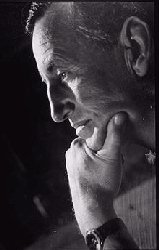
Fact File
- Ian Lancaster Fleming was born on May 28, 1908 into a wealthy family,
which owned Fleming's Bank. Like his brother Peter, the writer of many
popular travel books, has was educated at Eton.
- Fleming died of heart failure at the age of 56 in 1964. Fleming
bought the demolished Warneford Place, formerly the home of Lord
Banbury, in 1960. He moved in with his wife Ann when building on the
new Sevenhampton Place was completed three years later.
- The Flemings already had a home in Jamaica, but Sevenhampton was
regarded as his true home, albeit for a brief period before his death,
and he kept in touch with local affairs. He became vice-president of
Swindon Artists' Society, made donations to local clubs and backed his
prospective Tory MP Charles Morrision in 1964.
- 0070 was the German diplomatic code used to send the Zimmerman
telegram from Berlin to Washington. According to a report in the
Swindon Advertiser, dated August 15, 1964.
- The closest you can get to Sevenhampton via public transport is the
South Marston Industrial Park. Dropped there by the No.7 bus, it's a
further two-mile hike to the village by way of a long and winding
road, passing along the way the Maranatha Christian School.
|
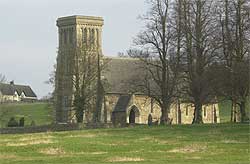 Welcome to Sevenhampton Welcome to Sevenhampton
FOR those bereft of private transport, Sevenhampton is all but
cut-off from the rest of the county. Incredible when you think this tiny
hamlet of 20 or 30 houses is actually no more than a 20-minute bus ride
(if buses actually travelled there) from the Swindon's bus station
But it's worth a visit, if only to pay homage to one of the UK's
best-known authors. Someone whose gold-plated typewriter turned the
vodka martini (shaken, you understand, not stirred) into the world's
most iconic drink.
Yet despite the cultural phenomenon spawned by this ex-navy intelligence
officer's suave, urbane creation, nothing in this village exists to
indicate that the author of one of Britain's best loved exports lies
buried here, together with his wife, Ann, and son, Caspar. Indeed, it
seems almost incomprehensible that Ian Fleming, who gave the world the
double-zero prefix and Pussy Galore, should lie so undisturbed in such a
modest little grave.
True, instead of a gravestone, there is an obelisk within the 20 or so
other gravestones that neatly surround Fleming's last resting place, but
cast aside any thoughts of grandeur - it is a plain, very modest
memorial that gives no hint that the body lying beneath entrusted to the
world the jewel that is Bond . . . James Bond.
The village is home to a collection of houses so perfect and
picture-postcard pretty you could be forgiven for thinking you'd
wandered into an episode of The X-Files. A single red phone box even
boasts a Yellow Pages - in perfect condition, with not a single page
torn or even creased.

The church itself is small but perfectly formed, another delightful
miniature and falls under the umbrella of the parish of St Michael and
All Angels, Highworth, the deanery of Swindon and the diocese of
Bristol.
Fleming's grave is to the left of the church gate, along a well-kept
path, looking forlorn and austere. The memorial simply reads: "In
Memoriam Ian Fleming B 28 May 1908 D 12 Aug 1964. Omnia perfunctus vitae
praemia marces". Buried with him is his wife Ann: "Ann
Geraldine Mary Fleming 1913-1981. There is none like her, none" and
his son, Caspar: "Caspar Robert Fleming 1952 - 1975: To cease upon
the midnight with no pain"
|
Den förste skådespelare som spelade
James Bond var inte Sean Connery utan , en norskättad amerikan vid
namn Barry Nelson.
Ian Flemings första Bond-roman, "Casino Royale,"
gavs ut i England 1953 och i USA året därpå.
Ian Fleming sålde snabbt filmrättigheterna till romanen till tv-bolaget CBS för
endast 1000 dollar. Redan året därpå, 1954, visades som en tv-film i USA.
Den 21 oktober 1954, kl 20.30, visades i amerikansk tv en timslång
omarbetning av Casino Royale i form av en direktsänd teaterpjäs.
Programmet ingick i serien "CBS Climax Mystery Theater", där
man varje vecka sände spänningshistorier i teaterform. Direktsändningen medförde
givetvis vissa begränsningar i återgivningen av bokens intrig. Filmen var
uppdelad i tre akter för att ge utrymme för reklamavbrott.
Regissören hette William H Brown och programmet presenterades av William
Lundigan. Man hade tagit sig vissa friheter med Flemings originaltext. Bond
var här en amerikansk agent och hade fått öknamnet "Card Sense Jimmy
Bond". Felix Leiter hade blivit brittisk agent, men hade fått förnamnet
Clarence.
Bond spelades alltså av Barry Nelson, medan
skurken Le Chiffre spelades av ingen mindre än Peter Lorre, känd från
storfilmer som "Casablanca". Linda Christian hade den
kvinnliga huvudrollen som Valerie Mathis (i boken heter hon ju Vesper Lynd).
Intrigen följde annars romanen rätt väl och utspelades i Monte Carlo vid
baccarat-bordet.
En hel del övertydliga förklaringar av casinospel fick läggas in i filmens
dialog eftersom tv-publiken inte automatiskt kunde förväntas känna till hur
man t ex spelar Baccarat eller Chemin de fer.
TV-programmet vållade ingen uppståndelse, fick halvbra kritik
och glömdes sedan bort. Länge trodde man att inget bevarats till eftervärlden
av denna version av Casino Royale.
En filmsamlare vid namn Jim Shoenberger gick 1981 igenom gamla
filmburkar med innehåll som skulle kastas, och återupptäckte då en välbevarad
upptagning av programmet. Om det inte hade angivits "svart/vitt" på
filmburken, hade Shoenberger kastat bort innehållet i tron att det var 1967 års
Casino Royale-film. Han upptäckte då att filmrullen innehöll 1954 års
tv-film.
Det gamla TV-programmet visades sedan offentligt för första gången
i juli 1981 vid en James Bond Weekend i Los Angeles. Barry Nelson var inbjuden
hedersgäst.
"Min roll var illa skriven, utan charm eller någonting. Min entré i
programmet var verkligen komisk och det var inte bra, för det var inte alls
meningen", sade Nelson i en intervju.
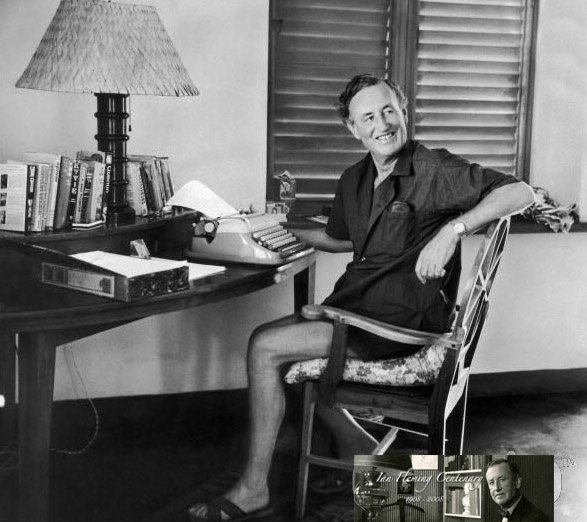 |
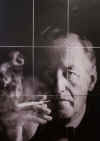 Ian Fleming big
Ian Fleming big |
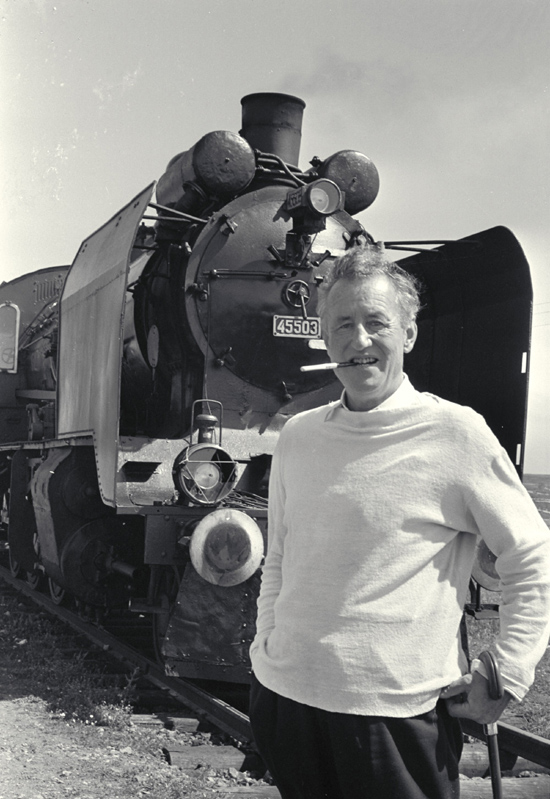
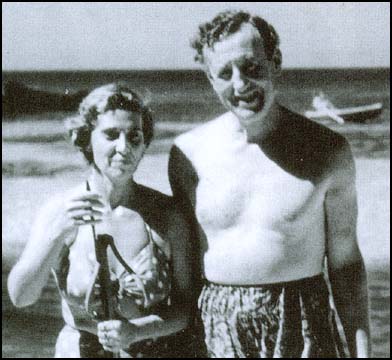
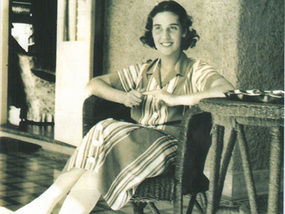
Ian Fleming Blanche Blackwell Ian Fleming Blanche Blackwell
|
London-based perfumery Ian Flemings Floris whose No. 89 Eau de
Toilette Ian Flemings favourit
James Bond first ordered his trademark drink when he met CIA
agent Felix Leiter in an early chapter in Ian Fleming's debut
novel "Casino Royale", first published in 1953:
The Fleming 89, meanwhile, was created in partnership
with London-based perfumery Ian Flemings Floris whose No. 89 Eau de
Toilette was Bond’s signature scent.
Inspired by tonka
beans used in the cologne, |
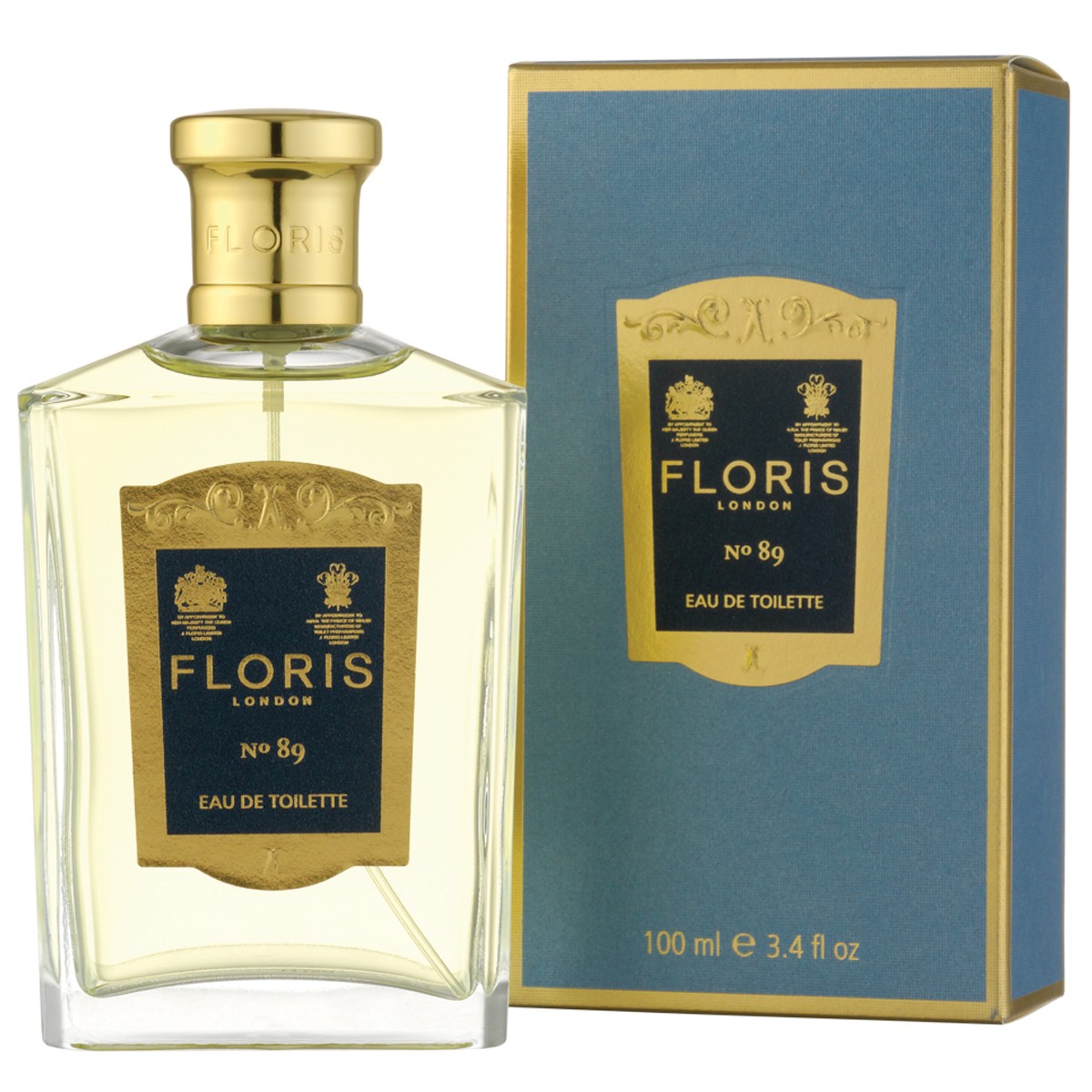 |
No. 89 Eau de Toilette
Citrus Woody
Description
Orange and bergamot blended with
lavender and neroli give No.89 its
classical cologne aspect. Warmed
with a touch of spicy nutmeg, the
floral heart is underscored by the
dominant woody accord of sandalwood,
cedarwood and vetiver in this
quintessentially English gentleman's
fragrance.
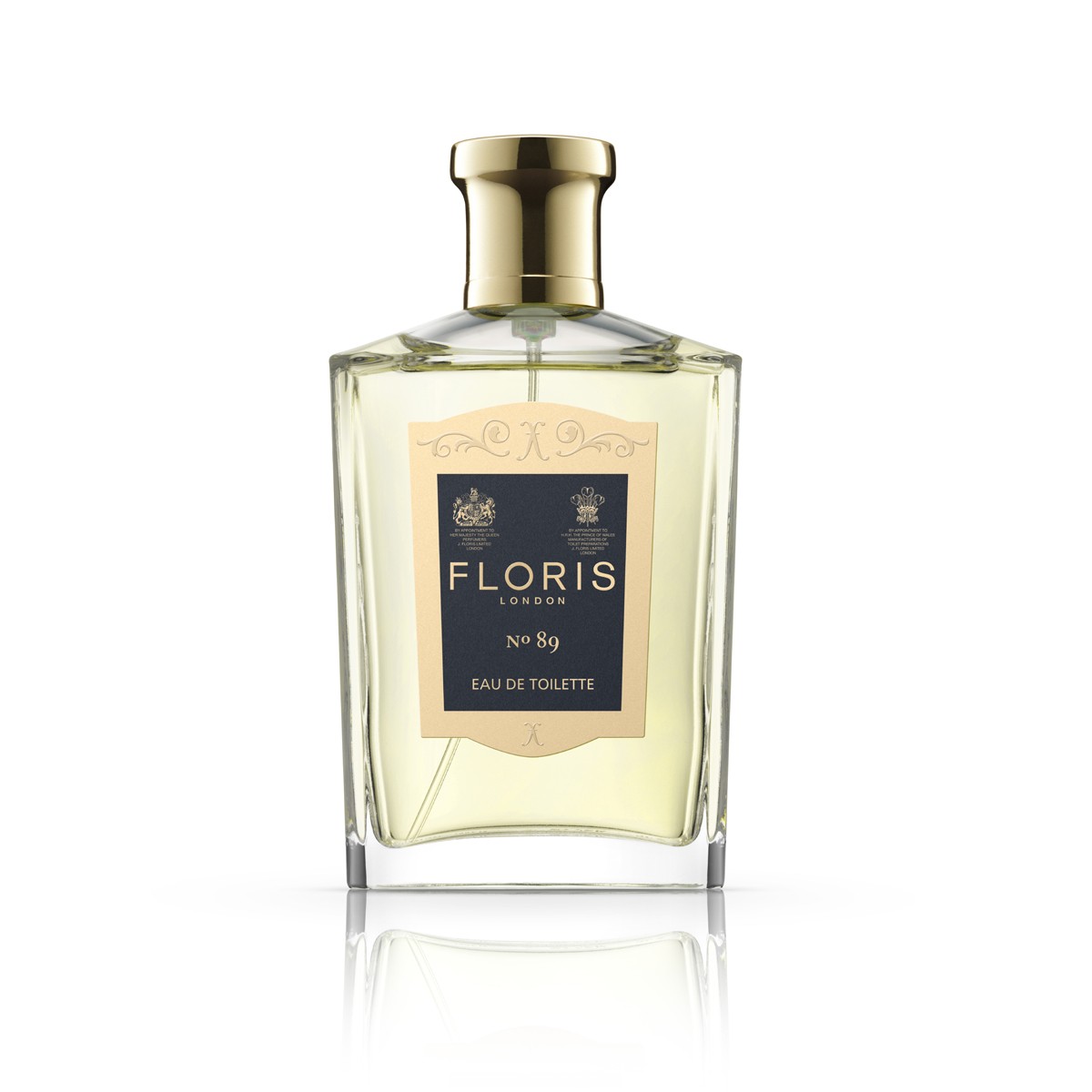 |
Floris
No.89
fragrance
was a
personal
favourite
of Ian
Fleming
himself.
Floris
is
mentioned
by Ian
Fleming
in the
novels
Moonraker
("Floris
provides
the
soaps
and
lotions
in the
lavatories
and
bedrooms"),
Diamonds
Are
Forever
("He
would
have to
send a
cable to
May to
get
things
fixed.
Let’s
see -
flowers,
bath
essence
from
Floris,
air the
sheets...")
and
Dr. No
("There
was
everything
in the
bathroom
- Floris
Lime
bath
essence
for men
and
Guerlain
bathcubes
for
women.").
No.89
takes
its name
from the
number
of the
Floris
shop on
Jermyn
Street.
Orange
and
bergamot
blended
with
lavender
and
neroli
give
No.89
its
classical
cologne
aspect.
Warmed
with a
touch of
spicy
nutmeg,
the
floral
heart is
underscored
by the
dominant
woody
accord
of
sandalwood,
cedarwood
and
vetiver
in this
quintessentially
English
gentleman's
fragrance.
Floris
makes a
complete
range of
No.89
fragranced
toiletries
for men,
including
Aftershave,
Aftershave
Balm,
Moisturising
Bath and
Shower
Gel,
Luxury
Soap and
Shaving
Soap and
Bowl.
The Eau
de
Toilette
is
available
in 100ml
or 50ml
bottles.
Floris
No. 89
Eau de
Toilette
is now
available
online
on
You can
also buy
Floris
89 at
the
original
Floris
shop at
89
Jermyn
Street,
London,
SW1Y
6JH.
|
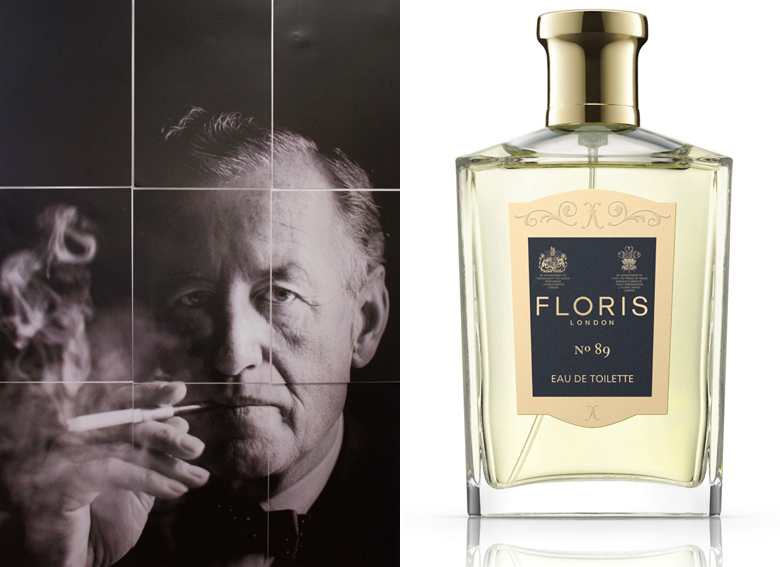 |










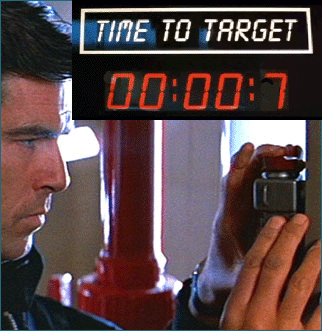























 Övriga utgivningar av Ian Fleming
Övriga utgivningar av Ian Fleming

 Welcome to Sevenhampton
Welcome to Sevenhampton
